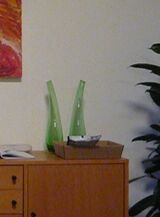Noise reduction with enfuse
Noise Reduction with Enfuse using image stacks.
It is a well known fact that digital cameras have increasing noise levels using high(er) ISO values in low light conditions.
Most modern cameras nowadays have builtin noise reduction systems to overcome this noise. These builtin systems mostly come in 2-3 steps ranging from light correction (leaving more noise, but preserving sharpness in the photo) to aggressive noise reduction (removing most of the noise at the cost of sharpness, thereby creating more blurred photos).
Noise is random. It is therefore also randomly distributed in your photo. Making image stacks and merging them into one image will reduce these random patterns. The better imaging software contain filters to allow you to merge image stacks by layering them and working with opacity (or other options).
Enfuse is much simpler. Just feed a stack of images into Enfuse and it will merge them fine, thereby removing the random pixels that give the noise in your images.
A method I often use, is by using the "(high) speed burst" mode on my camera. The "(high) speed burst" mode is normally meant for fast changing scenes, e.g. sports, to capture the right moment. It's also a great mode to swiftly capture a stack of images.
For this example I just positioned the tripod, set my camera to "(high) speed burst" mode, pressed the release button for approx. 3 seconds and had 24 images: easy as that. (Never mind the composition, it's only an example)
(Off course: In low light conditions your high speed burst mode might end up in a reduced speed burst mode due to longer shutter speeds. Still you can capture quite some images in short time). In the table below you will find the: single exposure, 6 merged exposures, 12 merged exposures and 24 merged exposures.
| Normal images | ||||
| Cropped images | ||||
| Cropped images 200% |
If you examine the "single exposure" image you will see severe noise in the whitish wall, the green vases, the cardboard box and in the beech wood dresser. From the above examples you can see the noise is strongly reduced in the "6 merged exposures" and almost no longer existent in the "12 merged exposure" version. The "24 merged exposure" is even better.
Quality is always relative. Decide for yourself how far you want to go.
Note: No (un)sharpening has been applied to above images, as they are meant to only show the denoising effect. Your final enfused image will get softer, so for your own final image you might want to apply some (un)sharpening.
Exposure fusion and noise reduction.
The exposure fusion and noise reduction can be combined if necessary. Say you want to photograph a city skyline at night, or a nice building at night enlightened with spotlights. This is a perfect situation for enfuse. You take for example images at -3, -1.5, 0, 1.5 and 3 EV and get a nicely fused image. It might still contain quite some noise. Shoot e.g. 4+ (the more, the better) images at -3, at -1.5, at 0, at 1.5 and at 3 EV and feed this 20+ images into Enfuse. The result will be a nicely fused image with hardly any noise.
Some last notes and remarks.
- "Does this work if I copy an image 12 times (or so) and use the above mentioned technique?" ==NO==, it does not. Remember that noise is a random pattern. If you copy the same image a number of times, the noise will always be in the same pixels, so it no longer is a random pattern.
- Switch off your camera's noise reduction system or set it to a low setting. When using image stacks you want your input images as sharp as possible.
- Use a tripod and if possible a remote shutter controller. Align your images with align_image_stack before enfusing them. Your images will improve, especially in sharpness.
- You might also want to take a look at the Image Stacking article. Enfuse is also an excellent tool for that purpose.
- It is best to apply some (un)sharpening to your finale enfused image as it will get softer then your source images no matter how sturdy your tripod is.











